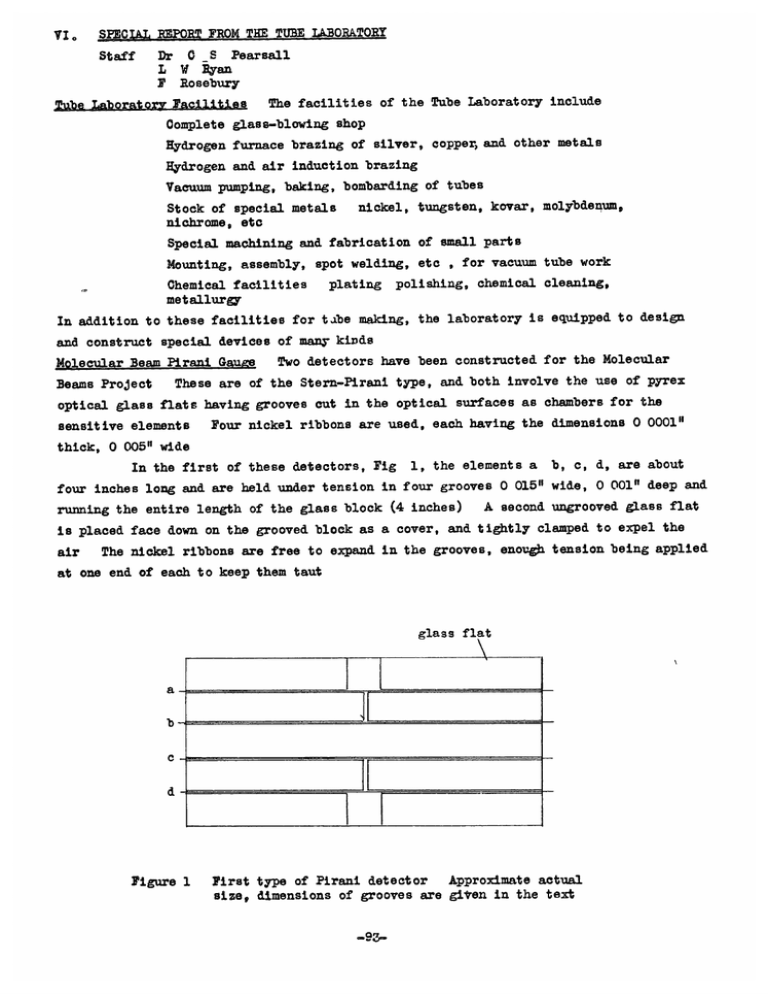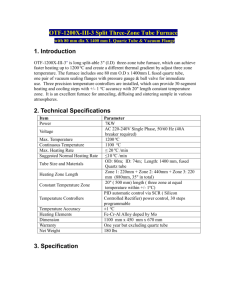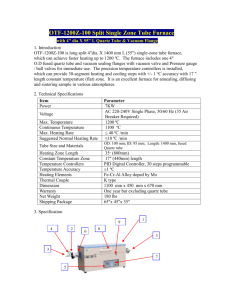TUBE LABORATORY VI. Staff L W Ryan
advertisement

VI. SLi.L REPORT FROM THE TUBE LABORATORY Dr 0 S Pearsall Staff L W Ryan P Rosebury Tube Laboratory Facilities The facilities of the Tube Laboratory include Oomplete glass-blowing shop Hydrogen furnace brazing of silver, copper,and other metals Hydrogen and air induction brazing Vacuum pumping, baking, bombarding of tubes Stock of special metals nichrome, etc nickel, tungsten, kovar, molybdenum, Special machining and fabrication of small parts Mounting, assembly, spot welding, etc , for vacuum tube work plating polishing, chemical cleaning, Chemical facilities metallurgy In addition to these facilities for tabe making, the laboratory is equipped to design and construct special devices of many kinds Two detectors have been constructed for the Molecular These are of the Stern-Pirani type, and both involve the use of pyrex Beams Project optical glass flats having grooves cut in the optical surfaces as chambers for the Four nickel ribbons are used, each having the dimensions 0 0001" sensitive elements Molecular Beam Pirani Gauge thick, 0 005" wide In the first of these detectors, Fig 1, the elements a b, c, d, are about four inches long and are held under tension in four grooves 0 015" wide, 0 001" deep and A second ungrooved glass flat running the entire length of the glass block (4 inches) is placed face down on the grooved block as a cover, and tightly clamped to expel the The nickel ribbons are free to expand in the grooves, enough tension being applied air at one end of each to keep them taut glass flat a b- c d Figure 1 Approximate actual First type of Pirani detector size, dimensions of grooves are given in the text M93- In the second apparatus block, which is two inches wide Fig 2, two grooves 1 1/4" long run across the These grooves are 0 060" wide and 0 010" deep and there are two nickel ribbons in each, a, b, c trical contact d, held under tension, and not in elec- A second block with matching, similar grooves is placed face down upon the first but is separated from it by several pieces of gold foil 0 0005" thick, so as to form chambers and slits and to block off the two chambers The whole is clamped together with uniform pressure g'ass fla* gold foil Figure 2 Second type of Pirani detector Approximate actual size, dimensions of grooves are given in the text In each case the detectors are enclosed in shield boxes and mounted on closure plates of the molecular beam apparatus with a mechanism for adjusting the slit The second instrument is equipped angle and height. Pick= Tube for Electronic Potential Mapping In connection with the potential mapping project, a pickup tube was constructed which consisted of an electron beam source, an anode, two pickup grids close to the anode, and a focusing shield A second tube has been completed in which there are sixteen grids arranged in mosaic, with two grid-anode spacings and two intergrid spacings Other Projects Among the other projects in which the Tube Laboratory has given material assistance are 5-mm Oxford type tube High-power 10-cm magnetron Transmission of energy from radiation on silicon crystals, investigations on other semi-conductors also Microwave spectroscopy Low temperature research superconductivity of lead Microwave linear accelerator Travelling-wave tube Impeller tube (Laboratory for Nuclear Science and Engineering) Electron collector (LNSE) Square-law diode (electronzc differential analyzer) Electrostatic storage tubes (Servomechanisms Laboratory) -94- Construction of a 60-kva vertical hydrogen brazing oven using Globar Projects Planned. heating elements and a gas-tight retort or chamber of moly-chrome-nickel furnace will have approximate dimensions as follows Maxmum temperature will be about 120000 20 inches all I This steel D 14 inches, length inside This furnace will be used for types of eutectic and pure metal brazing up to the meltipg point of copper Construction of small x-ray diffraction apparatus for metallographic analysis Investigation of intermediate melting-point solders and brazing alloys Expansion of facilities for induction brazing, with and without hydrogen atmosphere, and in vacuo. Resum of Recent Work in (1) Qaeium Chemical Section being developed to hold hot caesium vapor in spectroscopy distilling Pure caesium is A quartz resonant cavity is connection with the work on microwave- produced by reducing the chloride with calcium and the product in vacuo The caesium prepared in this manner can be heated in an evacuated quartz tube to 45000 without evidence of reaction with the quartz, above 52000 there is appreciable reaction with the walls. The quartz cavities are machined to size with a diamond wheel. (2) Eiah Tmeerature Furnace A small electron bombardment furnace is under construc- tion for work on the properties of semi-conductors, and for sintering refractory catnode materials such as thorium oxide 25000 to 300000 is It This furnace will cover the temperature range consists of a small crucible support surrounded by a heater which mounted inside two tantalum radiation shields The assembly is enclosed in a pyrex tube with a ground joint to facilitate removal of the sample (3) Thorium Oxide Cathodes Work is now in progress on the production of pure Th0 2 cathodes for high-power magnetrons The requirements for a suitable thorium oxide cylindrical cathode are (a) that it good resistance to thermal shock electron emission is (4) must have high density, and (b) that it The effect must have of impurities and addition agents on the being investigated Trideutero-ammonia Equipment has been set up to produce trideutero-ammonia for microwave gas work. The method consists of passing deuterium oxie vapor over freshly prepared magnesium nitride (5) Square P yrex Tubin In connection with work on some special types of Dewar flasks a method of drawing pyrex tubing with square cross section has been developed With suitably shaped mandrels, a large variety of cross sections may be produced Facilities of Chemical Section The Chemical Section maintains facilities for electro- plating and electropolishing of metals, and is also completely equipped for the chemical cleaning of special metals used in vacuum tube work equipped to do metallographic work The Laboratory is Facilities are also available for special work in ceramics, such as steatites and pure oxide refractories -95-




